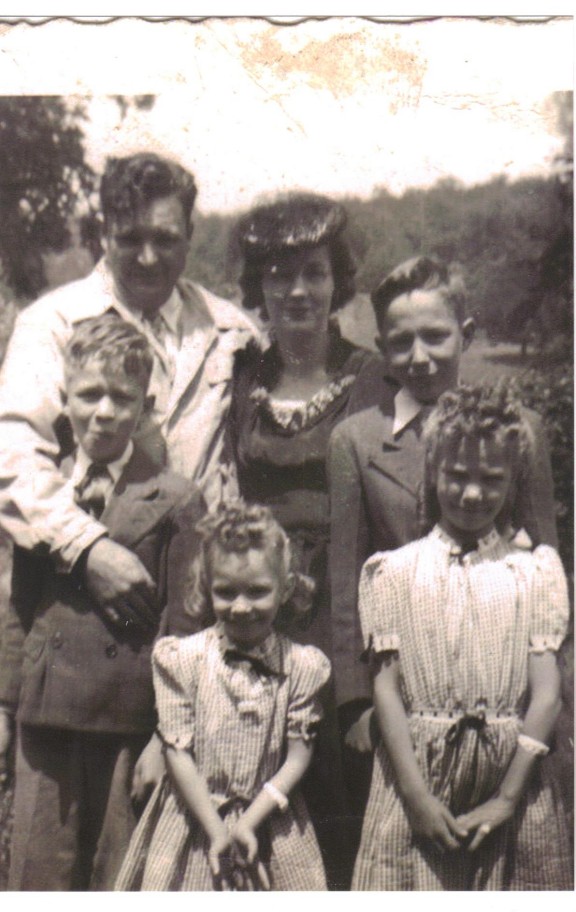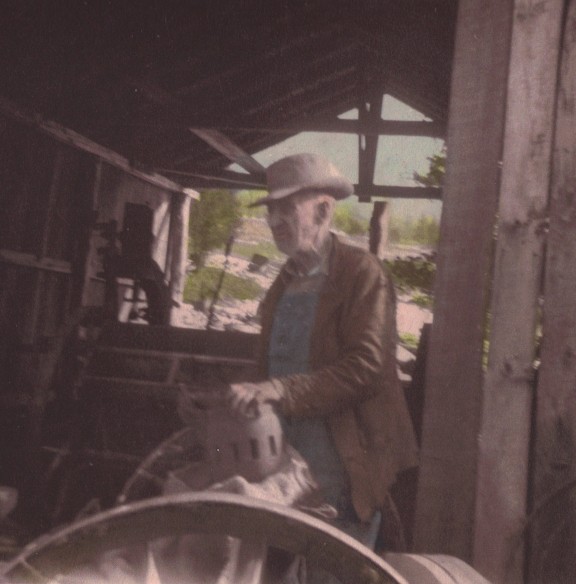
The photograph showing a view of old Highway 42 north at a time when it was just a graveled road was shared with me by Joe H. Copeland of 523 Zachary Street in Livingston. Although the Overton Restaurant was not there when this picture was taken, the person with the camera had to be standing near the area where the restaurant was later built. One of the families who lived on that stretch of highway several years after that picture was taken was Floyd Bilbrey and wife Ethelene (Parrish) Bilbrey. Family members can’t say for certain if the white framed house they lived in is the same one in the photograph, but the house they lived in was located in that same area. The children in the Bilbrey family were as follows: Robert Lee; A.B.; Geneva; Joe; Jewell; Bill; Roxie; Herman; and Vestel. Floyd Bilbrey was a sharecropper and farmed the Henson property on both sides of the road. Crops that he grew included corn, hay, strawberries, and cane. The Bilbrey family also raised cattle, hogs, and chickens. Money made from a nearby molasses mill helped put the Bilbrey children through school.

Sue Ann (Copeland) Sells, daughter of Jimmy Copeland and wife Leida (Ringley) Copeland, has these memories about the time her family lived along that highway: "When I can first remember the road, early to middle 40’s, there were less than a dozen homes between the intersection and the quarry. The first house on the left was the Averitt house. That home was owned by the widow of John Kelly (Jack) Averitt, Mrs. Louellen (Clark) Averitt. Later, Mrs. Averitt’s son, Burns Averitt, his wife, Sibby, and Sibby’s daughter, Judy Barnes, lived in the home, but moved from there in the 60’s.
"Joe and Norene Copeland lived in the next house on the left. Their children’s names were Donald, Norita, and Louise. After Mr. Copeland passed away, I believe Mrs. Copeland moved to Nashville. Norita and Louise live there now. Lester and Ruby Winningham and family later moved into this house.
"Zachary’s lived in the next house. Coy Zachary worked for the power company and Mrs. Zachary was a beautician. Louise Zachary, Mr. Zachary’s daughter from a previous marriage, taught for a very short time at Livingston Academy while her husband, Dr. Joe Capps, was in the service.
"The first house on the right was on the Henson property. Jim Myers managed this property. Foster Ledford and his family were the first family I remember living there. In the 50’s, there was a drive-in -theater between the Overton Restaurant/Motel and the old bowling alley building.
"Next was a house built by Joe Dalton. Mrs. Thelma Delaney, wife of Estil Delaney, was a Dalton. She told me that there was a pond on the Henson property next to their house. One day as she and her siblings were fishing from the pond, all of a sudden the pond sank, and about scared the wits out of them. Perry Windle family lived in this house. The Jimmy Copeland family moved here in 1945.
"Next, on the right, was where my grandfather lived. My grandfather, born on West Fork, was William Elvin Copeland. He had a twin brother, William Alvin, who died as an infant. Most people called my grandfather Billy or Uncle Billy. His first wife was Lula Smith. Their children were Estelle, Jimmy, Hettie, Lizzie, Dimple, and Arnold. Dimple and Arnold died as infants. Lula Copeland died about 1929. Isaac Wesley (West or Ike) Copeland, my grandfather’s father, was living with the family when he died in 1930. After the death of his first wife, William Copeland married Ina Belle (Kimes) Spicer in 1936. They had a son, William Alvin. Ina Copeland had three children by a previous marriage whose names were Frank, Donald, and Juanita Spicer.
"My grandfather’s blacksmith shop was the next building on the right.
"Raymond and Bernice Denton lived in the next house on the right. They had two daughters, Maxine, who married Bob Hill, and Betty Jo, who married Doc Parsons. According to family history, Dr. Romaine Billings’ family lived in this house when my daddy was a young boy. Troy Collins and his family lived in the next house during the late 40’s. I believe there were 3 children, but do not remember their names. They moved to Michigan. The Ledbetter family lived in next house on the left. The children were Billy and Joann. After the death of Mrs. Ledbetter, Mr. Ledbetter later remarried and there were other children by that marriage. Vaughns lived in the next house on the left. The children were Bobby, Johnnie Marie (Ledbetter), and Troy. There was another house on the right. Several families lived in this house.

William Elvin Copeland was known as "Uncle Billy" to everyone who knew him. He is pictured in front of his blacksmith shop that once stood on old Highway 42 north.
"My grandfather, William (Billy) Copeland, fondly referred to as Uncle Billy, was a blacksmith. He built horse drawn wagons and wooden truck beds. He made hand tools, garden hoes, shovels, etc. He also sharpened and repaired tools as well. All of the children wanted to master working the billows. Sometimes he would let us try, but most of the time, he did it himself, as we were not very good at this job. There was certainly an art to this chore as a steady rhythm had to be maintained in order to keep the fire at the correct temperature. It was amazing to watch him take a strip of metal, heat it in fire, take it to the anvil and produce a circle that fit a wagon wheel perfectly. This was a hot job and my grandfather was a hard worker. When he came in for dinner, his clothes would not have a dry thread. Bill Coleman once told me that if he had a piece of machinery at the quarry to break down, he would take the broken part to my grandfather. He would make a duplicate and the equipment would be back up and running long before Mr. Coleman could order the part. Many times, it wasn’t even possible to order a part. My grandfather and his brother, Elliot, a gunsmith, sometimes worked as carpenters. My grandfather did not own an automobile, although I remember being told that he could drive, so he must have owned one or had access to one at some time. He walked to town. He usually did not have to walk all the way because someone would stop and offer him a ride, usually before he got out of sight of home. At times, he would hitch ole Maude to the wagon to go into town if he had to haul feed or take grain to the mill. In later years, probably around 1954, his younger son did have a car. He always had a big garden and grew the feed for the chickens and hogs. He planted several acres of corn and grass for hay. I learned to drive in the hay field. Hog killing day was always special. Rendering the fat and making cracklings took all day. There was a smoke house where hams and bacon was cured and stored. My parents married in 1931, a time when money was very scarce. Dad hired Sid Howard's taxi cab to take him to Old Hickory to look for work. He used a pistol as collateral. He got the job and worked for Dupont until 1948. My mother stayed at my grandfather’ home until after my oldest brother was born. The children in my family were James Lloyd, Billy Ray, Sue Ann, Dolores Gaye, and George Stephen. We visited my grandfather as often as possible on the weekends and during the summers. There was gas rationing during the war. Although the car was almost loaded to capacity with 2 adults and 4 children, my dad always stopped and picked up as many hitchhiking soldiers as could fit into the car. I once overheard my parent discussing the fact that Dad had been to town to pay the $2.00 poll tax. You could donate a day to the county by working on the roads if you were not able to pay tax.
"My mother, my siblings, and I always spent summers at my grandfather's home. My parents bought the house next door to my grandfather from Perry Windle, Sr., in 1942. After that, we begin spending summers at that house and moved there in 1945. My dad started his own business after moving back to Overton County in 1948. He did upholstering and furniture refinishing. We had a big garden, a cow, a goat, pigs and chickens. We traded eggs at Mr. Boswell's store at the intersection. One year, the hens were not laying many eggs, and everyone needed eggs for Easter baking. Mr. Boswell was paying five cents ($.60/dozen) for eggs. A good trade if you were craving a candy bar or bottle of soda. When Jimmy Lewis brought the chicken industry to Overton County, we raised chickens. The Fourth of July was usually spent picking blackberries. Our family did not grow strawberries but my older brothers, sister, and I picked for neighboring farmers. During the time I grew up, everyone used skeleton keys, but no one ever bothered to locks their doors."
When the photograph of the old road was taken, life was completely different than it is today. Even though that was only 75 or 80 years ago, the changes that have taken place since then are almost unbelievable. Many homes had no electricity or running water, very few people owned automobiles, and there were no modern conveniences we not only make use of on a daily basis today, but most of them are just taken for granted.
Henry Wadsworth Longfellow had this to say about change:
Nothing that is can pause or stay;
The moon will wax, the moon will wane;
The mist and cloud will turn to rain;
The rain to mist and cloud again;
Tomorrow be today.